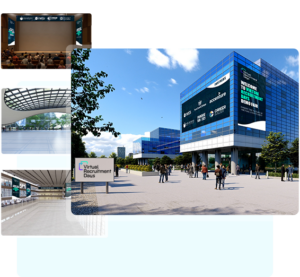In a rapidly evolving digital environment, virtual events have become essential to modern connection, allowing businesses to connect with audiences around the world, promote teamwork, and exchange expertise. The advantages of virtual events are apparent, but they are not without technical difficulties.
The virtual event scene demands meticulous planning and technological expertise to navigate, from internet connectivity challenges to audiovisual faults and security concerns. In this guide, we dig into the world of virtual events and examine methods for overcoming the typical technological difficulties that organizers and participants could run across. Understanding and addressing these issues is crucial to ensuring a seamless and effective virtual event experience for all parties, whether you are organizing a webinar, conference, or trade fair. Here are some typical technical issues and solutions for them:
1. Internet Connectivity Issues
Encourage attendees to use a stable and high-speed internet connection as a solution. Provide guidelines on how to improve their internet settings and reduce network snarl-up during the event.
2. Platform Acceptance
Choose a reliable and user-friendly virtual event platform that supports various devices and operating systems. Ensure that attendees receive clear instructions on system requirements and compatibility.
3. Audio and Video Quality
Prioritize high-quality audio and video equipment for presenters. Conduct technical rehearsals to test audio and video settings, ensuring they meet professional standards.
4. Screen Sharing and Presentation Problems
Instruct presenters on how to share their screens effectively. Encourage them to use compatible file formats and practice screen sharing in advance.
5. User Training and Technical Support
Offer training sessions or tutorials for attendees and presenters to familiarize themselves with the virtual event platform. Provide real-time technical support during the event via chat, email, or dedicated support lines.
6. Security and Privacy Concerns
Implement robust security measures to protect against unauthorized access and data breaches. Use password protection, secure meeting links, and encryption. Educate attendees on safe online practices.
7. Chat and Interaction Issues
Ensure that chat functions and interactive features are intuitive and user-friendly. Have moderators or technical support personnel monitor chats for questions and issues.
8. Engagement and Interactivity
Encourage audience participation by using surveys, Q&A sessions, and interactive exercises. Select a virtual event platform with integrated tools and features for interaction.
9. Platform Reliability and Downtime
Select a reputable virtual event platform with a strong track record of uptime and reliability. Have a backup plan in case of platform issues, such as pre-recorded content that can be played during downtime.
10. Content Accessibility
Ensure that all written and visual materials, such as presentations and documents, are usable by people with impairments. Offer transcripts, closed captioning, and screen reader compatibility.
11. Virtual Event Load and Scalability
Choose a platform that can accommodate the anticipated volume of participants and interactions. Adjust resources as necessary to handle peak loads.
12. Recording and Archiving
Record sessions and make them accessible for on-demand viewing as a solution. Allow guests who might have missed the live event to access archived content.
13. Testing and Rehearsals
To detect and proactively address potential concerns, have full technical rehearsals with presenters and moderators.
14. Communication and Support Channels
Clearly communicate technical guidelines, troubleshooting steps, and support contact information to attendees. Provide a dedicated help desk or support team available to assist with technical challenges.
In conclusion, virtual events have enormous potential for fostering global connectivity and knowledge exchange, but they may encounter technical difficulties. Such difficulties can be overcome with careful preparation and proactive approaches. A strong internet connection, platform compatibility, high-quality audio, and security are essential. User involvement, support, and training initiatives are all equally important. By solving these issues, event planners may design smooth virtual encounters that are equal to in-person gatherings, encouraging deep connections and teamwork in the world of digital events. Undoubtedly, digital events are the way of the future, and knowing these technological details will help you make the transition smoothly.






